
And that is well before the current scene…

Tom's Blog on Life and Livingness

And that is well before the current scene…
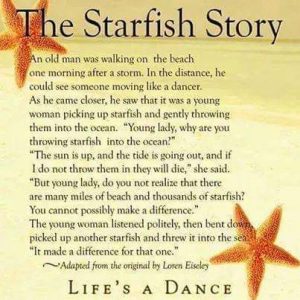
What you do DOES make a difference! Check out: https://www.bringorder.info/English.html
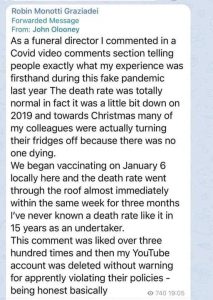
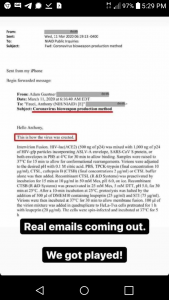
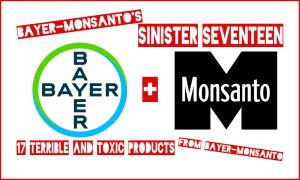
Bayer completed its purchase of Monsanto in 2018, in a move that the company’s own investors have rebelled against in recent months to the tune of a multi-billion dollar class action lawsuit against the company.
Since then, the German pesticide, GMO and pharmaceutical company’s reputation had been considerably damaged due to being associated with Monsanto and its ongoing Roundup/cancer lawsuits.
Bayer and Monsanto have a lot in common, starting with the toxic products they have brought to market.
This is just a shortlist of the top reasons – the ‘Toxic 16’ – why you should boycott Bayer-Monsanto, an unethical corporation and a scourge on humanity and the planet.
1. Agent Orange
Monsanto became one of the two primary manufacturers of this war chemical during the early 1960s.
This combination of 2,4-D and 2,4,5-T was used often for chemical warfare during the Vietnam War as an herbicide and defoliant. Monsanto’s formula had far more dioxin, a byproduct considered one of the most toxic substances known to man, than the version made by Dow Chemical.
Exposure to the chemical has left a legacy of multi-generational birth defects, cancer, and countless other diseases in military veterans and the Vietnamese people.
2. Aldicarb
Classified as “extremely hazardous” by the World Health Organization, its highest category, this pesticide created by Bayer was previously used on citrus trees before 2010, when Bayer and the EPA reached an agreement to stop using it.
It’s classified as a dangerous neurotoxin. Despite these risks, the EPA has recently considered reapproving it.
3. Aspartame
Discovered accidentally during research on gastrointestinal hormones, Monsanto acquired manufacturer G.D. Searle in 1985 and began marketing the controversial sweetener as NutraSweet.
While it is still deemed to be safe by the FDA, the U.S. Department of Health and Human Services previously released a report listing 94 health issues that may be caused by the sweetener and a recent French study linked it to increased risk of breast and obesity-related cancers.
4. Atomic Bomb and Nuclear Weapons
Monsanto acquired the Thomas and Hochwalt Laboratories and turned their division into its own Central Research Department.
From 1943 to 1945, the group coordinated techniques to refine chemicals for use in atomic weapons.
5. Baycol
In 2001, Bayer recalled this drug for patients with high cholesterol after it was reported to cause at least 31 deaths and was connected to a muscle disorder called rhabdomyolysis, a condition that caused the kidneys to clog with protein from dying or dead muscle tissue.
The recall cost Bayer $1.2 billion, and some reports have linked it to far more deaths.
6. Bovine Growth Hormone
Developed by Monsanto and three other companies including pharmaceutical giant Eli Lilly, recombinant bovine growth hormone, also known as rBST, has been shown to increase concentrations of IGF-1, a protein naturally found in milk. Higher blood levels of this protein have been linked to an increased risk of pre-menopausal breast cancer and other health problems.
rBST was banned in the EU in 1990. It is still allowed in the U.S., and the FDA doesn’t even require companies to label its use in their products.
7. DDT
Monsanto became one of the first manufacturers of this insecticide back in 1944.
In 1972, DDT was banned throughout the United States after the harmful effects of the chemical were revealed by outside research. A recent study suggests that granddaughters of women who were exposed to DDT decades ago are more likely to menstruate early, more susceptible to becoming obese and may even have a 4x higher risk of developing breast cancer.
The chemical was also linked to large-scale deaths of bald eagles and other birds, documented in Rachel Carson’s landmark book ‘Silent Spring.‘
8. Essure
Bayer began marketing Essure birth control devices in 2002 after receiving FDA approval as a female sterilization device that required no surgery.
Over the years, the product has injured tens of thousands of women. A 39,000 person class action lawsuit resulted in a $1.6 billion settlement from Bayer in 2020. Bayer has since discontinued Essure.
9. Ethoxyquin
Developed by Monsanto in the 1950s, this synthetic pesticide and antioxidant is not widely used in human food, but still used in pet foods and animal feed. It has been found to have toxic and mutagenic effects in animals and humans. You can read more about ethoxyquin in GMO/Toxin Free USA’s report.
10. Fossil Fuel-based Fertilizer
In 1955, Monsanto began manufacturing petroleum-based fertilizer after purchasing a major oil refinery. Petroleum-based fertilizers can kill beneficial soil microorganisms, sterilizing the soil and creating farmer dependence, like an addiction, to the synthetic replacements. Fertilizer runoff causes ground and water pollution and is responsible for algae blooms and massive marine life die-off. Not the best addiction to have, considering the impact of fossil fuel dependence on climate change…
11. GMOs
Also known as genetically modified organisms, the term GMO is used to describe a plant or animal that has been engineered in a lab.
Monsanto first brought gene-spliced corn, cotton, soy and canola with DNA from bacteria and viruses to market in the mid 1990s. Monsanto was the largest of the GMO seed corporations, but Bayer wasn’t far behind.
Both corporations have spent millions to keep these lab creations from being labeled. A database of studies showing evidence of harm, released by GMO/Toxin Free USA, has shed light on the countless health risks posed by these organisms.
Bayer’s 2018 acquisition of Monsanto makes the combined corporation the largest in the world for seeds and pesticides, owning 25% of the market.
12. HIV-Tainted, Blood-Clotting Medicines
A division of Bayer named Cutler Biological sold millions of dollars of HIV-tainted blood-clotting medicines to hemophiliacs, according to DrugWatch.com.
The medicine infected thousands in the U.S. and abroad with HIV and hepatitis C. Many died.
Bayer set up a $600 million fund with three other companies to settle lawsuits, but did not admit wrongdoing.
13. Neonics
Bayer patented a substance called imidacloprid back in 1985 as the first commercial neonicotinoid.
Neonicotinoids are a class of insecticides widely implicated in the destruction of bee and bird populations. These pesticides have been the subject of bans and lawsuits throughout Europe and beyond. While there is a growing movement to ban neonicotinoid insecticides in the U.S., they are still allowed and are widely used on many food crops.
14. PCBs
Monsanto began expanding its chemical operations into polychlorinated biphenyls (PCBs) during the early 1920s to produce coolant fluids for large-scale electrical equipment.
Fifty years later, tests exposed the immense health damage PCBs were causing to laboratory rats.
A decade later, the U.S. Environmental Protection Agency published a report citing PCBs as the cause of cancer in animals.
These substances were banned globally in 2001, but lawsuits by individuals, cities and states have continued against the company in recent years as PCBs are continually being found in bodies of water throughout the United States.
15. Polystyrene
This Bayer-produced synthetic plastic product is still widely used in packaging.
It ranked 5th in the EPA’s 1980s listing of chemicals whose production generates the most hazardous waste overall.
16. Roundup
The main ingredient in this popular herbicide is glyphosate, which was declared a “probable human carcinogen” back in 2015 by the International Agency for Research on Cancer.
Created by Monsanto, Roundup’s introduction has also led to ‘Roundup Ready’ genetically modified crops that have been engineered to withstand large doses of the toxic herbicide. Not only an herbicide, massive amounts of Roundup are sprayed on non-GMO crops such as peas, beans, lentils, sugarcane and grains to desiccate the crops for quicker and easier harvesting. Roundup is the most widely used herbicide in the world, now found falling down in rain and in most people’s blood.
Glyphosate was first patented by Stauffer Chemical as a chelator used to clean and descale commercial pipes and boilers, and later as an antibiotic thought to be effective against malaria.
Glyphosate binds to and removes vital minerals from our soil, our food and our bodies.
The antibiotic properties of glyphosate have been linked to damage to the microbiome in humans and soil. A healthy and diverse microbiome has been found to play a critical role in the immune system and in mental health.
17. Saccharin
Artificial sweetener, saccharin, was Monsanto’s first product.
Studies were carried out in the early 1970s and a 1998 study by the National Cancer institute linked the synthetic sweetener to cancer in humans. A warning label was added to the artificial sweetener and it was listed as a carcinogen. It was later banned for a short time but the ban was lifted when industry demanded more research and evidence.
It wasn’t government regulation that toppled saccharin, the first artificial sweetener —at least not directly. The threat of a saccharin ban led producers to research and create alternatives. In 1965 aspartame was discovered; in 1976 sucralose; and in 2002 neotame. Today, saccharin, once the undisputed king of artificial sweeteners, lags behind newer and competing synthetic sweeteners.
If you’re wise, you consume a good amount of fresh, organic foods, and a wide variety of them. This is especially true of colorful fruits and vegetables, herbs and spices. As it turns out, some of the plant chemicals (also known as phytochemicals) which give plants their vibrant colors also have unique powers to protect our health.
Blackberries, blueberries, raspberries, strawberries and other berries have been found to contain compounds including polyphenols, ellagitannins, anthocyanins and others. The phytochemicals provide vivid colors to the berries, adding an aesthetic touch to any meal which includes them. But the real miracle is the fact that these plant chemicals have powerful anti-oxidant and anti-cancer properties.
Studies have shown up to a 70% reduction in incidence of cancers in test animals given daily raspberry supplements. The ability of the berries to neutralize cancer-causing waste products and toxins in the cells is the probable reason.
Strawberries are high in Vitamin C, manganese and ellagic acid which imparts its color to the berries. Ellagic acid has been shown to help prevent cancer of the breast, skin, lung and esophagus. Polyphenols such as quercitin possess tremendous powers as well. Quercitin induces the programmed death of cancer cells, in a process known as apoptosis.
Note that organic berries contain substantially more of the beneficial plant compounds, without the poison herbicides or pesticides. So by all means, eat organic!
Indulge your taste buds while protecting your health this summer… enjoy the berries!
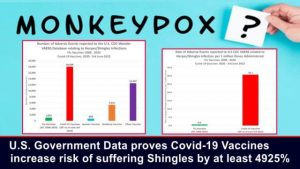
According to a scientific study published in 1988, it’s virtually impossible to distinguish between monkeypox and chickenpox. And chickenpox is caused by the varicella-zoster virus, and just like its close relative the herpes simplex virus, it becomes a lifelong resident in the body.
And like its other cousin, genital herpes, varicella may be silent for many years, hiding out inside nerve cells and can reactivate later, wreaking havoc in the form of the excruciating skin disorder, shingles, which is a blistering, burning skin rash.
Now, data made available by the U.S. Government, but more specifically the Centers for Disease Control (CDC) strongly suggests we’re not witnessing a monkeypox outbreak at all, but we’re instead witnessing a coverup of Covid-19 vaccine-induced shingles.
According to the CDC Wonder Vaccine Adverse Event Reporting System (VAERS) database, as of June 3rd 2022, the CDC has processed 18,026 reports relating to herpes and shingle infections that have occurred as adverse reactions to the Covid-19 injections.
And the vast majority of these reports have been a result of the mRNA Covid-19 injections by Moderna and Pfizer. The Janssen viral vector vaccine has had just 693 reports of herpes/shingles infections made against it. Whilst the Moderna vaccine has had 5,321, and the Pfizer jab a shocking 12,507.
Meanwhile, according to the same VAERS database, the CDC only received 1,052 reports relating to herpes/shingle infections that have occurred as adverse reactions to all available Flu jabs between the years 2008 and 2020.
This figure alone shows there has been a 1,614% increase in adverse events related to herpes/shingles because of the Covid-19 injections.
Many would try to argue this increase is simply because so many Covid-19 injections have been administered. But anyone who argues this would be entirely wrong because official CDC data shows nearly 3 times as many Flu jabs were administered between 2008 and 2020 than Covid-19 injections administered as of June 3rd 2022.
According to the CDC, 1.7 billion Flu jabs were administered between 2008 and 2020.
But according to ‘Our World in Data’, only 588.04 million Covid-19 jabs have been administered in the USA as of May 27th 2022.
Now that we know these figures we can use them to calculate the rate of adverse events related to herpes/shingles infections per 1 million doses administered.
Based on official data available for 2008 to 2020, there were 0.6 adverse events relating to herpes/shingles infections per 1 million doses of Flu vaccine administered in the USA.
But based on official data available up to 3rd June 2022, there have been 30.7 adverse events relating to herpes/shingles infections per 1 million doses of Covid-19 vaccine administered in the USA.
However, it’s important to note that the CDC have admitted they believe just 1 to 10% of adverse events are actually reported to VAERS, therefore the rates per 1 million doses could be significantly higher for both jabs.
But the available data shows the rate of adverse events relating to herpes/shingles infections per 1 million doses of Covid-19 injection administered is 4,925% higher than the rate of adverse events relating to herpes/shingles infections per 1 million doses of Flu vaccine administered.
Therefore, this official U.S. Government data proves that Covid-19 vaccination increases a person’s risk of developing Shingles by 4,925% at the very least.
The Emergency Committee of the World Health Organization is set to meet on Thursday 23rd June 2022, to assess whether the alleged monkeypox outbreak represents a public health emergency of international concern.
But it looks like they may actually be meeting to declare a Public Health Emergency of International Concern by the end of June 2022 over Covid-19 vaccine-induced shingles.

Are you young and considering “transitioning”? Please consider watching this. Only twenty minutes. And it’s your life on the line:
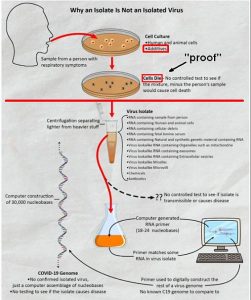
The germ theory has been derived via a pseudoscientific sleight of hand with no validation. Doctors and scientists are indoctrinated into a germ theory dogma, akin to a religion, appealing to authority, with no valid science whatsoever to back up their beliefs. Germ theory history is rife with political involvement, fear based agendas, erroneous testing methods, racketeering, superstition, story telling, silencing of truth tellers, suppression or demonizing of alternative theories, destruction of natural medicine fields and of course massive profit agendas. Those who were properly studying the bodily terrain in the late 1800s and early 1900s identified through important microscope inventions (ie the somatoscope), looked at the living blood and characterized a 16 stage microzyma (any pleomorphic organism inside any given body) somatid (Somatids are microscopic energy particles. They are found in all things including humans, animals, fruit, veg, and the sap of plants and also in lifeless organic matter like rocks and ashes. They are apparently indestructible.) cycle which proved that our entire body is full of life and this life is pleomorphic (able to assume different forms). Our own blood cells can change shape and function based on the pH of its environment into a white blood cell, into a bacteria, then into a yeast form, create a hyphae (a filament of the body of a fungus and of certain bacteria), a mold spore or even smaller particles that can look like what the modern world calls viruses.
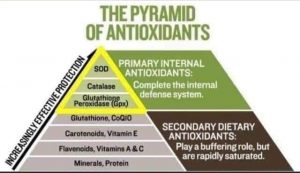
If you want to see which foods boost the ability of your body to produce glutathione I have listed them on a page on my web site. As well as a list of those I have included in my products.